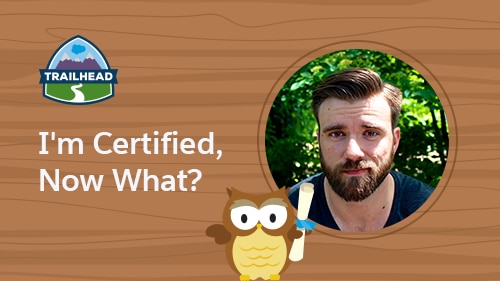I'm Salesforce Certified—Now What? Develop Your Career Strategy



In our “I'm Salesforce Certified—Now What?” series, we bring you hints and tips from the #SalesforceOhana on what your next steps should be after obtaining your hard-earned Salesforce credential. In our fourth post, 7x certified and self-confessed lover of Salesforce, John Garvens, shares his
In our “I’m Salesforce Certified—Now What?” series, we bring you hints and tips from the #SalesforceOhana on what your next steps should be after obtaining your hard-earned Salesforce credential. In our fourth post, 7x certified and self-confessed lover of Salesforce, John Garvens, shares his secrets on developing your career strategy in the Salesforce ecosystem.
Four years ago, I barely knew what Salesforce was. Three years ago, I touched Salesforce for the first time. Today, I am a senior consultant and technical trainer for a platinum Salesforce consulting partner, and a 7x Salesforce Certified Professional. I am also an active Vetforce coach, as well as a career coach.
With more than 150,000 customers and over 1,000 partners, it is no secret that the “Salesforce economy” is growing. In fact, demand for Salesforce-specific jobs has quadrupled since 2012. But competition for those jobs has increased as well.
To stand out, you need something most people never talk about: A career strategy.
While updating your resume with your new certification is important, developing your career strategy should take priority in the beginning. When you approach this strategically, you will make more progress in less time.
With that said, here are five strategies you can use, post-certification, to rapidly grow your career in the Salesforce ecosystem.
Strategy #1: Explore your career options, openly
You cannot find your dream job in the Salesforce ecosystem if you do not know what it is. That’s why you should spend time at the beginning of your job search exploring your career options and learning more about yourself, your interests, and your work preferences.
If you need some help, explore these Salesforce roles and note which job descriptions interest you the most. Here are some popular job titles:
- SalesforceAdministrator
- Salesforce Developer
- Salesforce Manager
- Salesforce Business Analyst
- Salesforce Consultant
- Salesforce Architect
- Salesforce Project Manager
Give yourself permission to dig into ideas and follow your curiosity. If you feel pressured to make a decision about what to do next, remind yourself that you are just “window shopping” right now—you will decide what to do later.
Strategy #2: Understand your work preferences, deeply
You need to identify what you do and do not want in your next job. Think of at least 10 answers for each of the following questions. Be ultra-specific. You want to deeply understand your work preferences and optimize your search for them.
- What types of activities do you enjoy most/least?
- What do you love/loathe about your current job?
- What makes you curious/bored?
- What types of challenges motivate/hinder you?
Look for patterns. What do you notice? What stands out? What surprises you? Finding the right job is less about your job title and more about your manager, your co-workers, and your day-to-day activities.
Strategy #3: Identify your ideal company, precisely
The Salesforce ecosystem is huge and sure to contain your ideal company. Think about what this looks like in terms of size, industry, and location. Answer these questions:
- What is your ideal company’s industry?
- How big is the company?
- Startup (1-24)
- Small (25-99)
- Medium (100-499)
- Large (500-999)
- Enterprise (1,000+)
- Where do you want to work?
- Country
- State/Province
- City
- Remote
Strategy #4: Network your way to a new job, Respectfully
According to Lou Adler, 85% of jobs are filled via networking. Eighty-five percent! When you have a strong network, you tap into the hidden job market and get jobs no one knows exist. You also make a bigger splash when you share exciting news like this:

The problem is most people network the wrong way. Here’s a crash course on how to build your Salesforce network. It’s pretty simple.
To begin, understand the process.
1. Hike where Trailblazers hike: live events and online communities.
- Attend Salesforce events, such as Dreamforce and Midwest Dreamin’.
- Join Salesforce user groups (mine is awesome) and go to user group meetings.
- Take Salesforce expert-led classes.
- Attend Salesforce learning events, such as TrailheaDX.
2. Meet other Trailblazers.
3. Connect on LinkedIn.
4. Find ways to help them.
5. On occasion, ask them for help.
If you cannot attend live events and courses, try meeting other Trailblazers virtually via email, LinkedIn, the Salesforce Trailblazer Community, /r/salesforce, etc. We’re all a part of the #SalesforceOhana. Reach out and connect with your family members!
Strategy #5: Apply for jobs, prudently
Ideally, you will find and land your next job through your robust Salesforce network. However, that is not always possible, and amazing jobs are still posted on public job boards. If you apply for a job online, keep a few things in mind.
- Apply for jobs at companies you like. Job applications take a long time to complete, and you need to use your time wisely. It makes no sense to work for a company you don’t love.
- Make sure your marketing materials (e.g., resume, cover letter, job application, etc.) target the niche you chose at the end of your exploration step.
- Actually write a cover letter, even if you think no one will read it. Because most people never write these anymore, you will stand out if you do. When writing your cover letter, answer the question, “Why do you want this job?” Don’t simply rewrite your resume.
Bonus Strategy: Track Your Applications, Systematically
I establish benchmarks for all sorts of things. Job applications are no exception. While benchmarks are not a perfect science, they give you a way to understand how you are doing. Here are my job application benchmarks:
- 10 applications
- 5 callbacks
- 2 interviews
For example, imagine you applied for 10 Salesforce Administrator jobs at 10 different companies. Based on my benchmarks, you should get callbacks from five companies and interviews with two companies. If you are not hitting those numbers, you need to regroup and figure out what needs improvement.
A low callback rate points to your resume and cover letter; a low interview rate points to your communication skills. The good news here? Resumes, cover letters, and communication skills can all be improved.
Hardly anyone establishes benchmarks for job applications. That is why you hear stories of people who apply for dozens or hundreds of jobs without getting a single callback or interview. By testing small and applying for only 10 jobs at a time, you’ll identify and bridge your gaps faster, landing your next job sooner.
You will make more progress in less time if you approach your career in the Salesforce ecosystem strategically. And if you do, you can start and grow your Salesforce career faster than you thought possible.
John Garvens is a senior consultant and technical trainer for Simplus, a Certified Platinum Salesforce Partner. He’s also a career coach, helping people start and grow their careers in the Salesforce ecosystem.

























